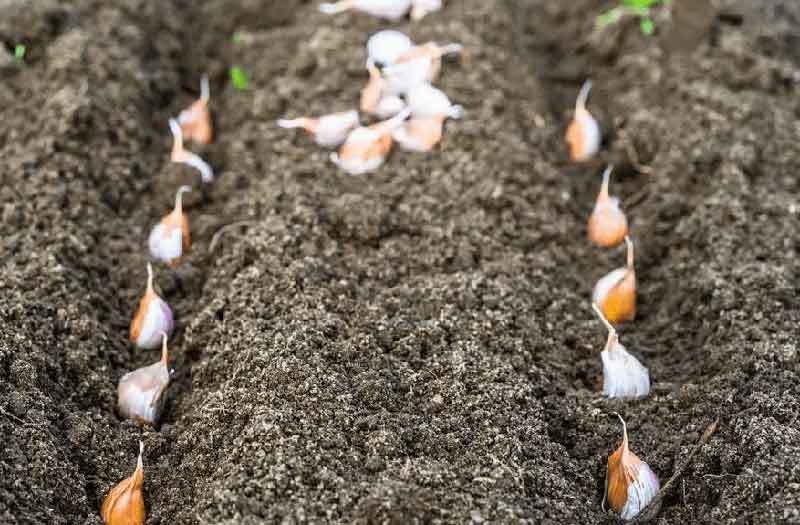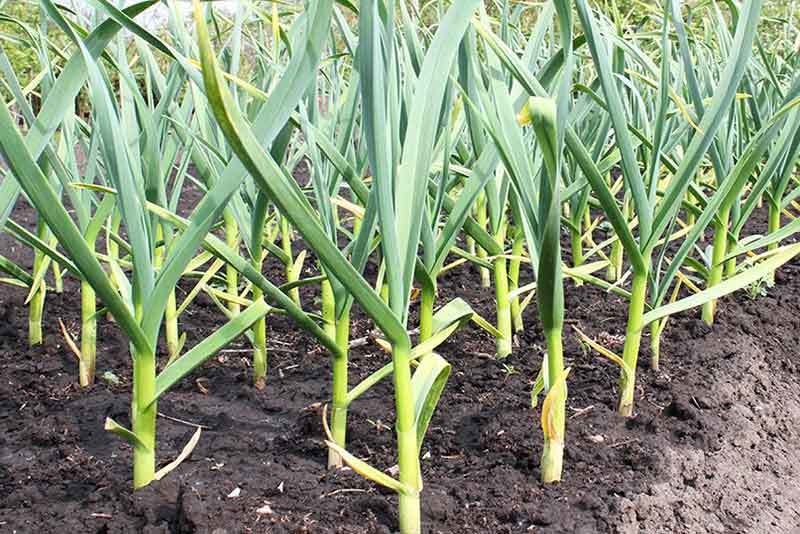Can you grow garlic in Missouri? We will explore the basics of garlic cultivation in Missouri. We'll discuss soil preparation, planting techniques, harvesting and storage tips. You can experience the joys of planting garlic in Missouri by following these simple steps.
Garlic is divided into two main categories: hardneck and softneck. Hardneck garlic produces flower stalks (or scapes) that curl up as the bulbs mature. While softneck varieties don’t produce any flower stalks at all.
Hardneck Garlic: Hardneck garlic typically has a stronger flavor profile than softneck varieties. It has a higher concentration of healthy compounds such as allicin. Some popular hardneck garlic varieties in Missouri include Music, German Extra Hardy, and Chesnok Red.
Softneck Garlic: Softneck garlic has a milder flavor than hardneck varieties. It is more suited for general cooking and baking. Some popular softneck varieties in Missouri include Silver White, California Early, and Inchelium Red.
You should consider the flavor profile and the climate. Hardneck garlic has a bolder, more robust flavor. It is better suited to cool climates. While softneck garlic has a milder flavor and is better adapted to warmer climates. In Missouri, both hardneck and softneck garlic varieties thrive. So you should consider your preferences and choose the best garlic to grow in Missouri.
If you are looking for a robust flavor, then a hardneck variety would be ideal. For example, Chesnok Red or German Extra Hardy. If you are looking for a milder flavor profile, then softneck varieties would be a better choice. For example, Silver White or California Early.
Choosing Healthy and Disease-free Garlic Bulbs: When growing garlic in Missouri, you should choose high-quality bulbs with no signs of disease or damage.
Guidance on Sourcing Bulbs: Many online companies offer fresh, high-quality selections. You should look for a reliable supplier. Many suppliers can provide garlic information and can give you advice for successful planting garlic in Missouri.
You'll find different garlic varieties from local farmer markets. From classic favorites like Silverskin and Elephant to less common varieties such as Turkish and Creole. Most farmers are happy to answer questions about the different varietals available.
Tips for Identifying High-quality Bulbs: When selecting garlic bulbs for cultivation in Missouri, look for firm cloves with no signs of damage or disease. In addition, try to pick bulbs that are the same size and weight. They will mature at the same rate when you plant them on the ground. This results in a more uniform crop yield.

Selecting a Suitable Planting Site: You should consider sunlight and soil type when selecting the site for your garlic patch. Garlic requires six to eight hours of direct sunlight per day. Soil drainage is also critical. Well-drained soil that does not remain water-logged is best. You should amend clay and heavy soils with compost or organic matter.
Soil Preparation: Test the soil pH level before growing garlic in Missouri. The ideal pH for garlic is 6-7. If you want to amend the soil, add lime or sulfur to achieve the desired pH level. You can add organic matter into clay soils.
Raised Beds: You can use raised beds if your areas have heavy rainfall. They will improve soil drainage and aeration. You can easily control weeds and harvest your crops.
When do you plant garlic in Missouri? Garlic has a long growing season. It will take 5-8 months from planting to harvest. So you should choose the right time to plant garlic in Missouri. The success of your garlic crop will depend on the climate and soil conditions in your region.
Recommended Planting Dates: Softneck garlic varieties generally require slightly earlier planting dates than hardneck varieties. For example, Silverskin and Artichoke. However, you should plant all the garlic before the first frost. In Missouri, this means planting softneck varieties in late August or early September and hardneck varieties in late September or early October.
How Does the First Frost Impact Garlic? The arrival of the first frost marks a crucial turning point for garlic growth. Garlic is a cold-hardy crop, but it can't tolerate freezing temperatures. After the first frost, most garlic varieties will stop growing and begin to die off. In Missouri, the first frost usually occurs in the second and third week of October. So you need to harvest your crop before this time. This ensures maximum yield and quality.
Step-by-Step Guide on Planting Garlic in Missouri: You should plant garlic cloves in the fall. About a month before the first frost. Before planting your garlic, break apart the bulb into cloves for easy planting and growth. Once you have your individual cloves ready, follow these steps:
1. Choose a garden bed in full sun with well-draining soil and no standing water.
2. Prepare the soil by digging six inches deep and working in up to four inches of compost or aged manure. This will help improve drainage.
3. Plant each garlic clove two to three inches deep. Space them about six inches apart. Be sure to point the tip of the clove up.
4. Water your garlic after planting. Make sure to keep the soil moist throughout the winter months.
Tips for Mulching: Mulching your garlic bed can provide extra insulation for the cloves, as well as suppressing weeds. You should spread a thick layer of straw or wood chips over the garden bed before winter arrives and left until springtime. This will help keep the soil temperature consistent during cold snaps. It also creates a warm environment for the cloves to grow.
When spring arrives, rake away any remaining mulch so that your garlic plants can get some direct sunlight. This will ensure each clove gets enough warmth for proper growth and development.
Regular Watering: Regular watering is critical for growing garlic in Missouri. Your garlic beds should be well-watered during dry periods in the fall and spring. Aim for one inch of water per week, either from rainfall or manual irrigation. Water deeply and infrequently will encourage deeper root growth. This can help the bulbs grow larger and more flavorful.
Fertilization: Fertilizing your garlic beds can also provide a boost to the crop. Choose a balanced organic fertilizer for best results. Apply at planting and again around mid-season, following label instructions carefully.
Removing Scapes: If you want larger garlic bulbs, it is important to remove scapes (flower stalks) from your plants. Removing the scapes encourages the plant to redirect its energy into bulb growth, rather than flowering. It is best practice to remove scapes once they become visible, as soon as possible after the garlic foliage has emerged.
Identifying Pests and Diseases: The common diseases include white mold and rust. White mold is a fungal disease caused by the fungus Sclerotinia sclerotiorum. It can spread quickly throughout a garlic field. Rust is caused by the fungal pathogen Puccinia allii. It affects both the foliage and bulbs.
The common pests include nematodes, onion thrips, wireworms, asparagus beetles and aphids. Nematodes are microscopic worms which feed on plant roots. This results in stunted growth and decreased yields. Onion thrips are small insects which cause leaf damage. They can damage the bulbs of garlic plants. Wireworms, asparagus beetles and aphids are all common insect pests. They feed on foliage, stems and fruits.
Natural and Organic Solutions for Pest Control: You should maintain a healthy soil environment to prevent pest infestation. You should use well-drained soil with organic matter. Planting garlic in raised beds can reduce pest infestations. You can also use companion planting. For example, planting garlic alongside onions or chives. This will deter pests from attacking your garlic plants.
You can also use neem oil. It is a natural insecticide derived from the neem tree. You can apply it as a spray or mixed with water. Spray it onto garlic plants to control insects and prevent fungal diseases. Compost tea is another organic solution for pest control. It contains beneficial bacteria that will help keep pests away from your garlic crop.
Crop Rotation: Practicing crop rotation is an important part of any garlic planting plan. Crop rotation prevents the buildup of soil-borne diseases. It also prevents nutrient depletion in the soil and reduces pest infestations. When planning your crop rotation, you should move garlic plants to a new location each year. So don't use the same soil for multiple years in a row. This reduces the chances of disease.
You should rotate different types of crops throughout your rotation plan. Planting garlic for one year. Then, plant tomatoes or peppers next year. This can encourage beneficial insects to feed on pests. It also keeps your garlic crop healthy and productive.

Signs of Maturity: You should look for a few signs when harvesting garlic. Garlic bulbs mature when the leaves of the plant begin to turn yellow and brown. The stems will also start to dry up. Once this occurs, your garlic is ready for harvest.
Proper harvesting: Harvesting garlic with a spade or shovel. First, carefully dig around the base of the plant. Loosen up the soil and remove the bulb from its roots. Gentlely during this process so as not to damage the garlic bulbs. When done correctly, you will harvest an entire clove without breaking it apart.
Once harvested, you should dry your garlic bulbs in a well-ventilated space. This can improve the flavor of the garlic and make it last longer when stored.
Cleaning and Trimming Cured Garlic Bulbs: You should carefully clean cured garlic bulbs with a dry brush or cloth. Remove any soil particles. Then, you can trim any root ends that may remain on the bulbs.
Benefits of Curing Garlic: Curing reduces moisture content. It also eliminates bacteria that may be living on garlic bulbs. Curing makes the flavor of your garlic more concentrated, making it even tastier!
Ideal Storage Conditions: You should store garlic in cool and dry conditions, ideally with a temperature between 50-60°F and a relative humidity of around 60%. Too much moisture can cause garlic to spoil faster. So make sure to keep it away from damp areas.
Storing in Braids, Mesh Bags or Containers: After trimming and cleaning the garlic bulbs, consider braiding them together for a decorative way to store them. Alternatively, you can hang mesh bags near your kitchen with bulbs inside. Garlic stored this way should keep for several weeks if kept in dry conditions.
If you cannot braid or hang the garlic, make sure to store it in a well-ventilated container. This will keep air circulating and reduce the risk of any moisture buildup inside.
Growing garlic in Missouri can provide your family with fresh, homegrown produce. It's also an incredibly rewarding experience for gardeners. With the right equipment and information, anyone can successfully plant garlic in Missouri.
Hot Products:
plastic flower pots wholesale 5 gallon nursery pots wholesale1 gallon nursery pots bulk 25 gallon nursery pots20 gallon nursery pots wholesale 15 gallon nursery pots wholesale2 gallon pots wholesale 1/2 gallon nursery pots wholesale3 gallon pots wholesale 10 gallon nursery pots wholesale4 gallon pot 7 gallon nursery pots wholesale1.5 gallon nursery potsName: Vincent Lee
Phone: 0086-15838107808
Wechat: Wilson15838107808
Whatsapp: 0086-15838107808
Email: vincentwilsongarden@gmail.com